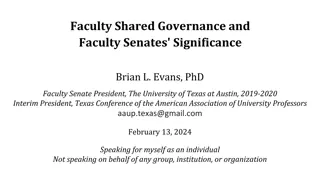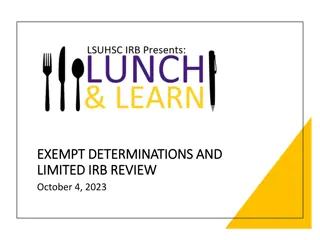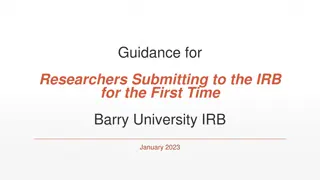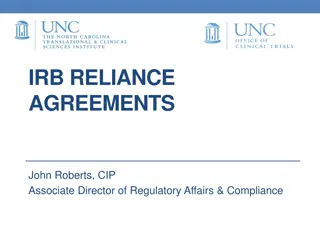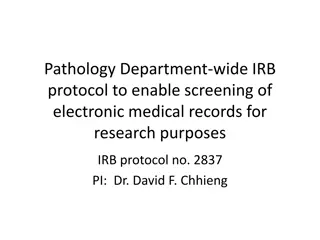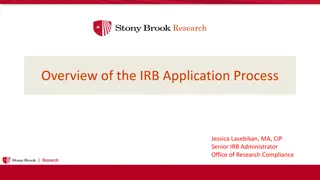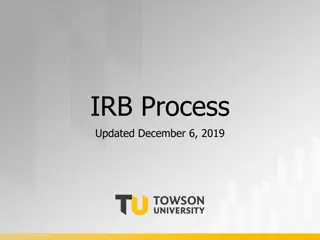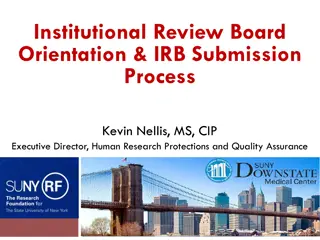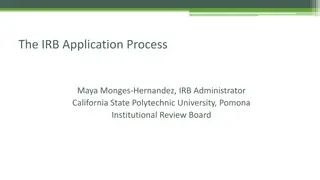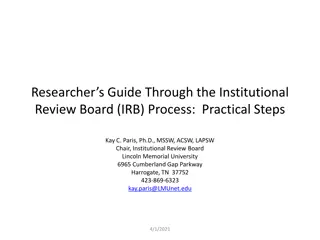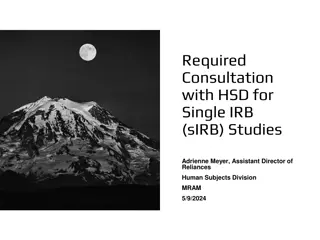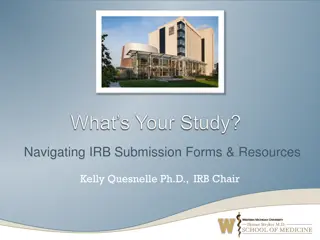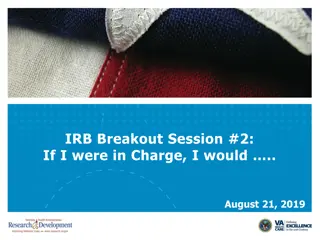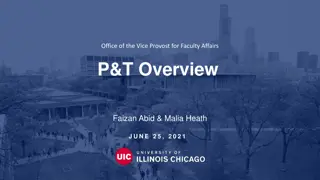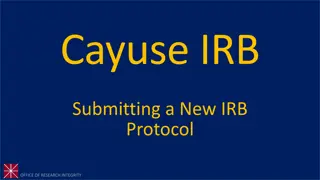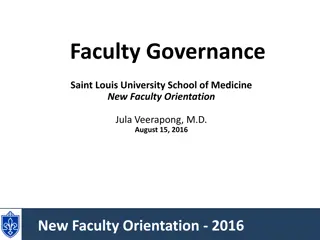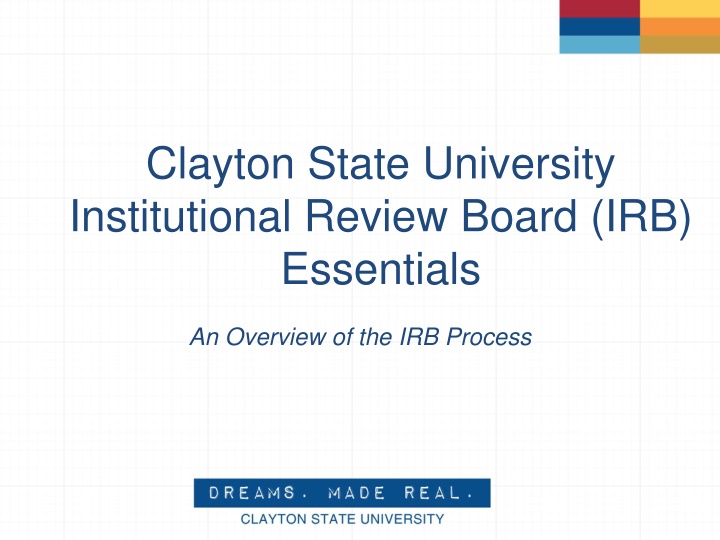
Clayton State University Institutional Review Board (IRB) Essentials
Learn about the Clayton State University Institutional Review Board (IRB), its role in protecting research participants, vulnerable populations, and researchers, and the importance of ethical considerations in human subjects research. Discover why human protection is necessary through historical examples like the Nazi Experiments and the Tuskegee Syphilis Study.
Download Presentation

Please find below an Image/Link to download the presentation.
The content on the website is provided AS IS for your information and personal use only. It may not be sold, licensed, or shared on other websites without obtaining consent from the author. If you encounter any issues during the download, it is possible that the publisher has removed the file from their server.
You are allowed to download the files provided on this website for personal or commercial use, subject to the condition that they are used lawfully. All files are the property of their respective owners.
The content on the website is provided AS IS for your information and personal use only. It may not be sold, licensed, or shared on other websites without obtaining consent from the author.
E N D
Presentation Transcript
Clayton State University Institutional Review Board (IRB) Essentials An Overview of the IRB Process
PART I: What is an IRB? Who Does IRB Protect?
What is an IRB? The IRB is an oversight committee governed by Federal regulations Role is to protect and manage risk to individuals who participate in research There are many projects for which the regulations do not require IRB review
What is an IRB? Anyone engaged in human subjects research at CSU must comply with regulations and policies for protecting participants. These include, but are not limited to: 45 CFR 46, DHHS 21 CFR 56, 21 CFR 50, 21 CFR 312, 21 CFR 812, FDA CSU IRB Policies & Procedures Ethical Principles in the Belmont Report VA and DOD policies and regulations
Who Does the IRB Protect? Institutional IRBs Protect Research participants Vulnerable populations Researchers from unintended errors The University s reputation and Federal funding status
Who are Vulnerable Populations? Disadvantaged groups whose freedom and capacity to protect themselves from inherent risks is reduced Children Pregnant women Fetuses Prisoners Employees Military persons Terminally ill Physically and intellectually challenged Institutionalized Economically and educationally disabled
Who are Vulnerable Populations? Due to their circumstances, such groups may feel that they must participate even if not voluntarily, or can be coerced by the expectation of benefits received or withheld Special considerations and heightened protection is therefore required
Examples of Why Human Protection is Necessary Ethical / Process Protection Legal / Procedural Response Trigger Event Autonomy, beneficence, consent, benefits > risks Nazi Experiments 1939-44 Nuremberg Code 1947 Tuskegee Syphilis Study 1932-72 Scope creep Informed consent Voluntary participation Benefits > risks Right to withdraw Privacy, confidentiality Independent review Community perspective Monitoring Protection of the vulnerable National Commission for Protection of Human Subjects of Biomedical and Behavioral Research 1974 (NIH); 1975 (CDC) Thalidomide Tragedy 1962 Milgram Study 1963 Secret Human Radiation Experiments (U.S.) 1944-74 Belmont Report 1979 Gene Transfer Participant Death 1999 Common Law 1991 Presidential Apologies 1997 Clinton 2011 Obama Tuskegee Syphilis Study Guatemala Syphilis Study
How does the IRB protect Human Subjects? Advise faculty about the conduct of ethical and responsible research Safeguard against researcher errors that can result in dire legal consequences to the researcher and the institution Provide a layer of oversight that ensures that the institution s reputation as well as its funding status are protected from ethical violations
How does the IRB protect Human Subjects? Judge whether potential benefits to the individual and to society warrant a person to undertake the risks of participating in the research Risk is defined as the probability of harm or injury occurring as a result of participating in research Risk of harm or injury can be physical, psychological, social, or economic
How does the IRB protect Human Subjects? Minimal risk is when the probability or magnitude of harm is judged to be no greater than those encountered in daily life or routinely encountered during physical or psychological exams Risks judged to be unreasonable relative to benefits cannot be approved Participation in research and potential risks and benefits need to be shared justly across different subpopulations
PART II: Who Should Submit? When to Submit? What to Submit?
Who should submit an IRB application? Faculty Member Graduate Students Principal investigator with a faculty co- investigator Masters studies are not included unless they involve human participants Principal Investigator of a research project Co-investigator (if PI is not affiliated with CSU) Supervisor of undergraduate or (non-thesis) graduate research Overseeing a class project where research is conducted as an assignment
When should you submit an application to the IRB? PRIOR TO engaging with study participants in ALL cases When a new study is being proposed
When should you submit an application to the IRB? Submit application to IRB a minimum of 6 weeks prior to the proposed start of your study Allows 4 weeks for IRB review and additional time for any requested modifications to be made
When should you submit an application to the IRB? Twelve months after initial approval, you must submit a continuation (for same study) OR-- A new application (for significant change in study population, scope, protocol or timeframe)
PART III: How to Determine if Your Study Needs Review
When is IRB review required? What types of projects must the IRB review? Start by looking at two definitions, and how your project fits: Human Subjects Research
Human Subjects Research DHHS Definition: A Human Subject is a living individual about whom an investigator obtains: 1. Data through intervention or interaction; or 2. Identifiable private information Identifiable if identity can be ascertained (e.g. 18 HIPAA identifiers) Private means a reasonable expectation that no recording is taking place, and information is used for intended purposes 45 CFR 46.102
Human Subjects Research FDA Definition: A Human Subject is an individual who is or becomes a participant in research, either as a recipient of the test article or as a control. May be either a healthy human or a patient. Clinical investigations with human specimens e.g. assays or in vitro diagnostic devices 21 CFR 50.3(g)
Human Subjects Research Typically does NOT include human subjects: Analysis of de-identified dataset Must ensure that participant cannot be re-identified Research with de-identified samples Exception for FDA definition, in which it is a clinical investigation involving human specimens Deceased individuals
De-identified Dataset Analyzing data collected previously, stripped of all possible identifiers Neither study team nor any collaborators have identifiers or a linking code Yes, it s research; but No human subjects because no interaction/no intervention/no identifiable information
Note on De-identified To the IRB, de-identified means: No one on study team has access to identifiers at any time For research at a CSU-covered entity, all 18 HIPAA identifiers are removed For research outside covered entity, it means that there is no feasible way to identify someone from the data (directly or via code) Typically national-level databases may appear de- identified but administrators state that re-identification is technically possible May require separate data use agreement The IRB will often review these
Human Subjects Research Research is a systematic investigation designed to contribute to generalizable knowledge. (paraphrased from 45 CFR 46.102)
Human Subjects Research Systematic Investigation? Methodical exploration of a question or theory Typically includes data collection and analysis Includes development, design, and testing phases
Human Subjects Research Typically Includes: Interviews, surveys, chart reviews, epidemiological studies, observational studies Typically does NOT include: Training others on how to use a device, provided activities do not include data collection/analysis
Human Subjects Research Designed to be Generalizable? Difficult to define, but typically designed to be generalizable if: Aims to draw conclusions about people or practices beyond a specific individual or internal program The intenttogeneralize makes it research, whether results are published or presented does not matter
Human Subjects Research Typically does NOT include: Quality Assurance/Quality Improvement Reports for funding agencies/ accreditation agencies Public Health Practice Case Reports (if small number of reports) Academic Course Evaluations Some Oral Histories and Biographies
Retrospective Chart Review Involves reviewing patient medical charts, or portions thereof, from specific, prior time period Key is determining intent: Are you wearing your clinician hat or researcher hat? Might be reviewing your own patients, but research aims makes it research Chart review for internal QA/QI purpose not likely research (not generalizable) Yes, it s research; and Yes with human subjects because the data will be identifiable
PART IV: What Are The Steps In the Application Process?
Research Determination Form Use the CSU Research Determination Form and confer with your IRB representative to determine the type of application to submit: Exempt: Not considered research that involves collecting personal information from human subjects and exposing them to related risks. Example: A change in an administrative practice. Expedited: Research involving human subjects that is a Class project that is guided by the Professor. Example: Testing a patient education module to produce specific changes in knowledge about the nature and benefits of a new intervention. Full Review: Research involving human subjects that is a complex study that involves risks. Example: Conducting a study to test a new behavioral intervention among cases as compared to the standard of care among controls to improve health behaviors and reduce disease symptoms. CSU Research Determination Form url (INSERT)
How to Submit an Application to the IRB Get assistance from your College or Department IRB Rep Complete the CSU Research Determination Form and consult with your IRB Representative as needed [URL] Select the Appropriate Application Application for Student or Class Project Application for Expedited Review Application for Full Review Complete and submit your Application package 6 weeks prior to expected start date to the CSU IRB Chair All researchers complete the NIH Protection of Research Subjects OR CITI Training and obtain their certificate https://phrp.nihtraining.com/users/login.php Application Student, Expedited or Full Review Completed form signed by PI and co-investigators Consent form Data collection instruments Analytic methods NIH certificates Handouts (including URLs)
Contact your IRB rep for a Determination Determining whether a project requires IRB oversight can have significant consequences. Unless absolutely sure, it is best to contact the IRB Best method is the form on our website under Applications Can always email the main IRB (irb@clayton.edu)
Where can I get trained for Protection of Human Research Participants? Everyone listed as a PI or co-investigator has to complete the National Institutes of Health (NIH) sponsored training: Protecting Human Research Participants (PHRP) Make sure your certificate is less than three years old and include it with your application
What about research continuing beyond a year? Continuations (Expedited and Full Reviews) Twelve months after initial approval, you must submit a continuation form if the study is to continue Failure to submit will automatically result in project termination Terminations (Expedited and Full Reviews) At the end of the study time period, a Termination form must be submitted Exempt Studies Not subject to monitoring, no requirement for continuation or termination If protocol changes result in risk factor changes, new application is required
IRB Audits of Approved Research Studies For active expedited and full-review studies, studies are randomly selected each semester: IRB representatives review the approved protocol and go over the current study with the Investigator using a check-list to determine if: The scope or mission has changed if so, a NEW application must be submitted before the research can continue If the scope has not changed, but the timeline has been extended, MUST be resubmitted to the IRB for an extension
Questions? For additional questions: 1. Contact your college IRB rep, or 2. Email irb@clayton.edu, or 3. Visit our website at: http://www.clayton.edu/provost/irb Acknowledgement: This presentation is based in part on IRB overview training provided by Emory University, and retrieved on 4/11/2017 from: https://tinyurl.com/ksz5vmj
PART V: EXAMPLES
Case Study / Case Series Involves reporting or presenting information on particular, individual cases. General approach is that a case series of 5 or fewer cases is not research Refers to whether it is generalizable HIPAA regulations should still be considered Series of 6 or more is like generalizable research, and IRB would likely review No, generally not research, unless series is >5 cases
Registry study Registry housed within USG or affiliate, and contains any identifiers, IRB would review Outside of USG, if we are just asked to contribute, the IRB may not need to review Must be no way for central Registry admin to link CSU data to identifiers; it is acceptable for CSU personnel to do that linkage Consent can be tricky, consult the IRB to avoid having unnecessary restrictions on data later May be human subjects research, depends where it is housed and the identifiability of data
Surveys May be online surveys or in-person, designed to gather and analyze data to investigate a question What if it s anonymous? Still involves human subjects, because it meets the interaction element, whether it has identifiable information doesn t matter It might, however, have an impact on the type of IRB review it has Yes, it s research; and Yes with human subjects.
Clear as mud? Same here! The regulations leave plenty of ambiguity and whether a particular project needs IRB oversight is not obvious Depends on particularities, often there are exceptions TAKEAWAY: Submit your project to the IRB for an official determination Determination request form on the IRB website is quick and convenient, not nearly as involved as an IRB submission. IRB is an independent body from Provost; decision appeal to IRB full board is final See our Policy and Guidelines document for details
Program Evaluation Typically an evaluation of an Emory process, or else an invitation to evaluate an external project e.g. public health activity overseas Look at intent and aims; designed to be generalizable? Publication doesn t necessarily imply research No, not research if not designed to be generalizable
Quality Assurance / Improvement Designed to improve a specific program or process Often includes obtaining data to measure effectiveness e.g. customer surveys, effectiveness of in-house initiatives, course evaluations, curriculum development May look exactly like scientific method behind research, the distinction can be tricky Consider specificity of project Publication does not necessary imply research No, not research if not designed to be generalizable
Public Health Practice Purpose is to improve health (preventing disease or injury) or to improve a public health program Key is the intent; designed to be generalizable? Opportunity for research may arise, concurrent with the practice Collaborators affiliation can be clue (e.g. health dept/ministry/bureau) No, not research if not designed to be generalizable
In Vitro Diagnostic Device An instrument, apparatus, implement, machine, contrivance, implant, in vitro reagent, or other related article, including any component, which is: Recognized in National Formulary, U.S. Pharmacopeia, or supplement to them; Intended for use in diagnosis, cure, treatment, prevention of disease; or Intended to affect structure/function of the body of man or other animals; and Does not achieve intended purpose through chemical action and is not dependent upon being metabolized. 21 CFR 809.3(a) paraphrased IVD study seems like not human subjects but if study is a clinical investigation per the FDA, it must be reviewed by the IRB Recall FDA definition of human subject Yes, research; and Yes human subjects (but depends on definitions, recommend you consult the IRB)





